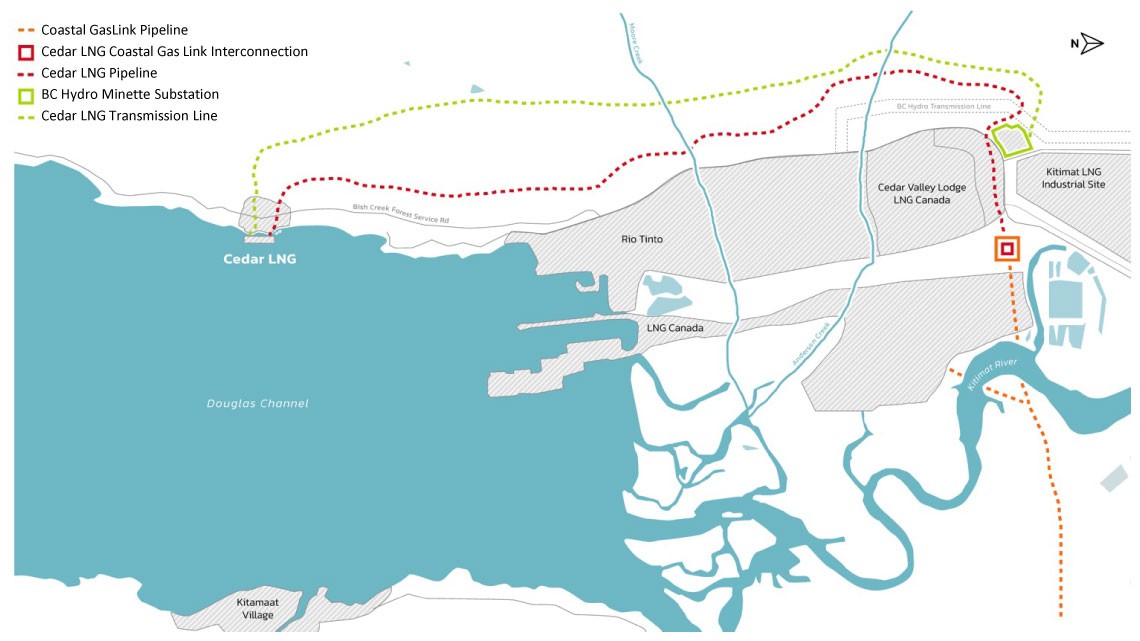B.C. gives Cedar LNG environmental approval
A final investment decision is expected later this year.

Officials announce major progress on Cedar LNG project. – Province of B.C.
Key Takeaways:
- Cedar LNG has received its Environmental Assessment Certificate from B.C.
- The project has also signed a memorandum of understanding with ARC Resources Ltd. for a long-term liquefaction services agreement
- A final investment decision for the project is anticipated in the third quarter of 2023.
- It would be the largest First Nations majority-owned infrastructure project in Canada.
The Whole Story:
Cedar LNG has received its Environmental Assessment Certificate (EAC) and signed a long-term liquefaction services agreement.
The Haisla Nation and Pembina Pipeline Corporation announced that the B.C. Environmental Assessment Office has issued the project its EAC. The project has also signed a Memorandum of Understanding with ARC Resources Ltd. for a long-term liquefaction services agreement.
Cedar LNG is a proposed floating liquified natural gas facility located on Haisla Nation-owned land in Kitimat, B.C. with the capacity to export three million tonnes per year of LNG. It is estimated to cost roughly $3.3 billion.
“The receipt of our EAC is the culmination of more than a decade of work by the Haisla Nation and marks a significant milestone for the Cedar LNG project and the Haisla Nation’s journey towards economic self-determination,” said Crystal Smith, chief councillor for Haisla Nation. “With Cedar LNG, we are setting a new standard of responsible and sustainable energy development. Together with our partner, Pembina, we are committed to advancing an LNG project that protects the environment, respects Haisla Nation values, and meets the highest standards of social and environmental responsibility.”
Pembina president and CEO Scott Burrows stated that the project will benefit Pembina and its customers, the Haisla Nation, and all of Canada, while meaningfully contributing to the transition to a lower-carbon economy.
“Pembina is proud of its long history of safe and reliable operations, and we look forward to contributing our expertise as we work together to bring Canadian LNG to the world,” he said.
Project officials noted that Cedar LNG made several innovative design decisions to minimize its environmental footprint and ensure it is one of the lowest-emitting LNG facilities in the world. This includes deciding to power the facility with renewable electricity from BC Hydro.
In addition, the choice of site location allows the project to leverage existing LNG infrastructure, including the Coastal GasLink pipeline, with which Cedar LNG has a long-term transportation agreement, a deep-water port, roads, and other infrastructure.

Cedar LNG also received its first permit from the BC Energy Regulator for the approximately 8.5 kilometre pipeline that will connect the Project into the Coastal GasLink pipeline.
The project team added that a major part of its success to date has been the strong support of neighbouring Nations. They explained that this has been achieved through years of collaboration and constructive engagement with these Nations.
Cedar and Arc are working towards finalizing a definitive agreement for 1.5 million tonnes of LNG per year, equivalent to approximately 200 million standard cubic feet per day of natural gas, or approximately half of Cedar LNG’s production.
“We are pleased to partner with Cedar LNG on this important infrastructure project for Canada. Through responsible development, innovation, and collaboration, we can advance the export of more Canadian energy to global markets,” said Terry Anderson, president and CEO, ARC Resources. “This agreement is an important step forward in delivering our low-cost, low-emission natural gas to key demand markets, and increasing ARC’s exposure to LNG-linked natural gas prices.”
Cedar LNG added that it continues to progress commercial discussions with other potential customers, all of which are investment grade counterparties, for long-term volume commitments.
The province also plans to enter into a memorandum of understanding with Haisla Nation to help the project achieve climate objectives, including exploring ways to enhance environmental performance and lower emissions to near zero by 2030.
“This decision was carefully made after considering all environmental impacts and comes with 16 legally enforceable conditions that Cedar must follow over the lifespan of the project, in addition to other oil and gas emission control regulations which government is developing,” said George Heyman, minister of environment and climate change strategy. “This project will take all possible measures currently available to reduce greenhouse gas emissions and the MOU between Haisla Nation and the province will explore ways to have the project work toward reaching near-zero emissions by 2030. With these measures in place, I have concluded that the project can fit within B.C.’s climate targets and goals.”
A final investment decision for the project is anticipated in the third quarter of 2023.
